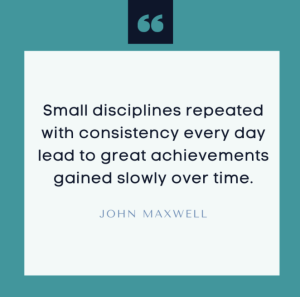Fast forward to December 31, 2022. What does your voice-over business look like? Did you achieve what you wanted to this year? If the idea of moving through another twelve months gets you to an unsure picture of what you intended to accomplish, it’s time to change not only how you set your goals, but how you set your daily actions to achieve those goals.
 Set Goals – And Make Them S.M.A.R.T.
Set Goals – And Make Them S.M.A.R.T.
S.M.A.R.T. is an acronym that you can use to guide your goal setting. To make sure your goals are clear and reachable, each one should follow the following criteria:
Specific: What do you want to achieve? Be specific with your goal.
Measurable: A measurable goal should address questions such as: How much? How many? How will I know when the goal is accomplished?
Achievable: Your goal needs to be realistic and attainable to be successful. How can I accomplish this goal? How realistic is the goal?
Relevant: This step is about ensuring your goal matters to you and that it also aligns with other relevant goals. A relevant goal can answer ‘yes’ to these questions: Does this seem worthwhile? Does this match my efforts/needs? Is this the right time? Will this goal align to my overall objectives?
Time bound: Every goal needs a target date; a deadline to focus on and something to work toward. A time-bound goal will answer the questions such as: When? What can I do today? 30 days? 90 days? 6 months? 12 months?
Putting it all together a SMART goal can look like this:
- Specific: I’m going to write a 66,000-word sci-fi novel.
- Measurable: I will finish writing 66,000 words in 6 months.
- Achievable: I will write 2,800 words per week.
- Relevant: I’ve always dreamed of becoming a professional writer.
- Time-bound: I will start writing tomorrow on January 1st, and finish June 30th.
SMART Goal Example Summary: I’m going to write a 65,000-word novel in 6 months, finishing on June 30th. I will do this by creating the daily routine of writing 400 words to reach a minimum of 2,800 words per week.
SMART goals can be set for all major areas of your life: Financial, Professional, Health and Fun. Writing them in the current tense is also important. It programs your mind to think of your goal as happening currently – it’s more concrete and creates something you can truly believe.
But setting the goal is just the beginning. To ensure you have any chance of making good on your goal achievement, doing consistent activities is where the real magic happens.
Break It Down
Setting a goal can sometimes feel like just words on paper. Breaking that goal down into real, actionable tasks creates the action needed to fulfill the goal’s promise. Great goals require a sense of vision – looking ahead six months, a year, or even further out provides the end game you need to motivate you. Goals such as these are important and necessary for you to achieve success. But breaking down these greater visionary goals is where you begin to really experience the outcomes. I suggest breaking down 12-month goals to 90-days(Quarterly), 30-day(Monthly), 7-days(Weekly) and Daily.
Let’s look at how this works with a very specific revenue goal:
Annual: I will book $25,000 or more in voice-over work by December 31, 2022.
Quarterly: I will book $6250 or more in voice-over work every quarter in 2022.
Monthly: I will book $2083 or more in voice-over work every month in 2022.
Weekly: I will book $521 or more in voice-over work every month in 2022.
Daily: I will book $75 or more in voice-over work every day in 2022.
How do the numbers feel as you move from the annual number to the daily number? For some of you, that annual number feels big, perhaps even unattainable. For others, you may need to create a bigger goal for yourself.
Either way, it’s important to see how that number breaks down, especially when it gets to monthly, weekly, and daily. Does it now feel more realistic and achievable? Does this mean you will book a gig for $75 every day this year? No. It’s simply a daily benchmark that leads to the weekly benchmark, that leads to the monthly benchmark, etc., so you can stay on track with your big goal.
This way you can focus on what you are doing daily to achieve that goal: how many auditions are you submitting, how many marketing emails are you sending, how many LinkedIn connections are you making?
You can even take some of these activities, create another annual goal, then break it down in the same way:
Annual: I will submit 1400 or more voice-over auditions by December 31, 2022.
Quarterly: I will submit 360 or more voice-over auditions every quarter in 2022.
Monthly: I will submit 120 or more voice-over auditions every month in 2022.
Weekly: I will submit 30 or more voice-over auditions every week in 2022.
Daily: I will submit 5 or more voice-over auditions every day in 2022.

By breaking down the activities that equate to revenue, you can now also start to see how your personal conversion numbers begin to play out. What is your average audition to booking ratio? What is the amount of your average voice-over project booking? These small, daily actions line right up to the big goal you’ve set. And focusing on those daily actions is much easier and feels much more attainable.
Make 2022 a year of setting and achieving your goals. Set them SMART, break them down, and then follow through with your consistent actions. Creating this discipline of daily activity will serve you well and ensure forward momentum to achieving the voice-over business you deserve.
Check out our free PDF with pro-tips from real working voice-over actors here!
Want to learn more about voiceover? Signup for our introductory VO webinar.





